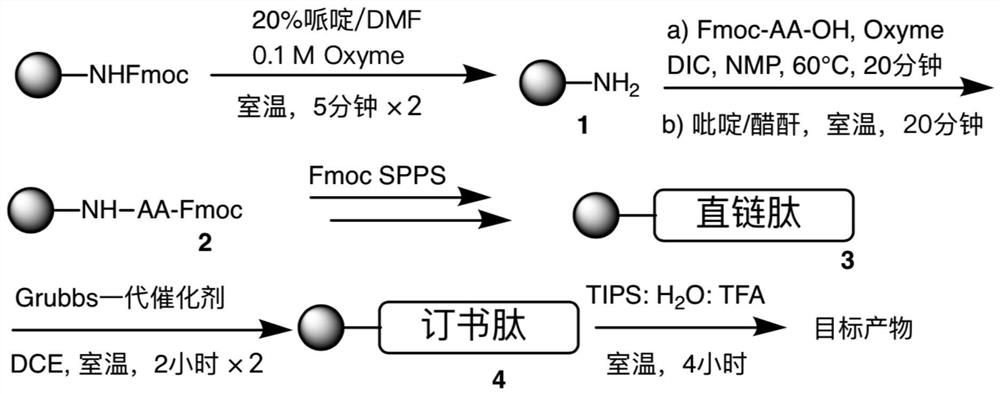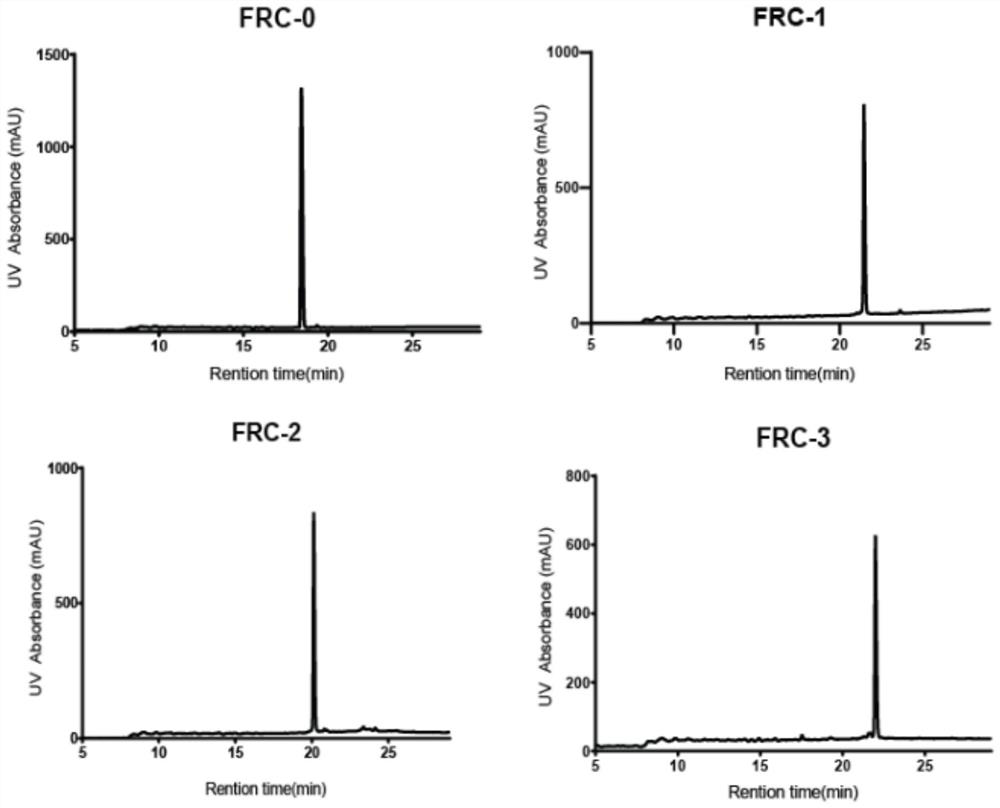A stapled peptide that inhibits osteoclast differentiation and its preparation method and application
A technology for inhibiting osteoclasts and stapling peptides, applied in the field of polypeptide drugs, can solve the problem of no osteoclast differentiation effect, and achieve the effect of inhibiting osteoclast differentiation and high productivity
- Summary
- Abstract
- Description
- Claims
- Application Information
AI Technical Summary
Problems solved by technology
Method used
Image
Examples
Embodiment 1
[0066] Example 1 Preparation of stapled peptides of the present invention that inhibit osteoclast differentiation
[0067] 1. Synthesis of stapled peptides
[0068] like figure 2 shown:
[0069] (1) Preparation of compound 1
[0070] Take 500 mg of amino resin (the sample loading is 0.30 mmol g -1 ) was added to the solid-phase synthesis reaction tube, soaked in DCM for 20 min to fully swell the resin, and drained for use.
[0071] Add 20% piperidine-DMF solution (0.1M Oxyme) until the resin is completely submerged, shake at 25°C for 5min×2 to remove Fmoc on the resin, wash the resin with DCM and DMF three times in turn.
[0072] (2) Preparation of compound 2
[0073] The first amino acid in the sequence (1 mmol), Oxyme (142 mg, 1 mmol) and DIC (155.0 μL, 1 mmol) were mixed in 6 ml of NMP, added to the resin and shaken at 60 °C for 20 min (S 5 The last amino acid was reacted for 1 h, and the reaction was repeated once), and the resin was washed three times with DCM and ...
Embodiment 2
[0086] Identification and structural analysis of the product of Example 2
[0087] The product obtained in step 2 of Example 1 was identified by HPLC and HR-Q-TOF-MS (high resolution matrix-assisted laser desorption ionization time-of-flight mass spectrometry) was used for structural analysis, and the chromatographic mobile phases were acetonitrile and water. Mobile phase A is an aqueous solution with a volume fraction of 0.1% TFA, mobile phase B is an acetonitrile solution with a volume fraction of 0.1% TFA, gradient elution (0-5min, mobile phase B: 5%; 5-30min, mobile phase B: 5%~90%); flow rate 15.0mL·min -1 ; Detection wavelength 214nm and 254nm, injection volume 20μl. It is determined that the peak time of the main peak of the crude product is consistent, and the purity of the stapled peptide prepared by this method is >98% ( Figure 3-4 ). The results were analyzed by HR-ESI-MS mass spectrometer as Figure 5-12 shown.
Embodiment 3
[0088] Example 3 Inhibition of Osteoclast Differentiation Experiment
[0089] TRAP staining assay: The formation of osteoclasts was quantitatively detected by TRAP-positive cells. BMMs were seeded into 96-well plates at a density of 8000 cells per well. After incubation for 24 h, BMMs were incubated with M-CSF at a concentration of 30 ng / ml, RANKL at 50 ng / mL and different concentrations of peptides (0, 20 and 40 μm). Change fresh medium every 2 days. After 5 days of osteoclast induction, the cells were washed twice with PBS, fixed in 4% paraformaldehyde (pH 7.4) for 10 min at room temperature, and stained with TRAP staining kit. Positive multinucleated osteoclasts were counted under light microscope, and the percentage of osteoclasts per well was measured using Image J software.
[0090] see the results Figure 13-14 , the stapled peptide of the present invention can inhibit the differentiation of osteoclasts, among which FRN-2, FRC-1, FRC-2 and FRC-3 have the most promin...
PUM
| Property | Measurement | Unit |
|---|---|---|
| purity | aaaaa | aaaaa |
Abstract
Description
Claims
Application Information
 Login to View More
Login to View More - R&D
- Intellectual Property
- Life Sciences
- Materials
- Tech Scout
- Unparalleled Data Quality
- Higher Quality Content
- 60% Fewer Hallucinations
Browse by: Latest US Patents, China's latest patents, Technical Efficacy Thesaurus, Application Domain, Technology Topic, Popular Technical Reports.
© 2025 PatSnap. All rights reserved.Legal|Privacy policy|Modern Slavery Act Transparency Statement|Sitemap|About US| Contact US: help@patsnap.com



